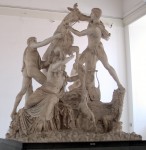On its discovery in 2008, it was hailed as one of the most significant Roman finds in decades. Digging down between the railway line and mechanics' workshops where the Tiber winds its way north out of Rome, archeologists found the remains of a 45ft high structure fronted by four columns. This was what was left of the luxurious tomb of Marcus Nonius Macrinus, the swaggering Roman general whose ceaseless campaigning in the 2nd century helped inspire Russell Crowe's film Gladiator.
 But now cuts mean the tomb may be buried all over again, according to Rome's extremely unhappy state superintendent forarchaeology. "I fear we are going to take into serious consideration the idea of protecting these sensational finds by re-covering the entire site with earth," said Mariarosaria Barbera.
But now cuts mean the tomb may be buried all over again, according to Rome's extremely unhappy state superintendent forarchaeology. "I fear we are going to take into serious consideration the idea of protecting these sensational finds by re-covering the entire site with earth," said Mariarosaria Barbera.Today, Macrinus's last resting place – in an industrial wasteland in the suburbs of Rome – appears forgotten. Delicately carved white capitals which were miraculously preserved for 1,800 years under thick clay now sit, discoloured by air pollution, in pools of rainwater, while cracks caused by winter ice have appeared in the stonework.
With funding for maintenance of Italy's archeological sites slashed by 20% since 2010 thanks to austerity cuts, the €2m-€3m (£1.6m-£2.4m) needed to preserve the tomb will not be available unless a sponsor is found soon, according to Barbera.
Covering up precious discoveries to protect them is getting more common in Italy as funding shrinks, she added. "Until now it has usually happened when remains are not that significant or monumental. In this case they clearly are."
A trusted friend of Emperor Marcus Aurelius, Macrinus won his spurs fighting Germanic tribes, just like Crowe's character, which was enough for the site to be known as "the Gladiator tomb". Beyond that the similarities end, since Macrinus did not fall out with the emperor's son nor become a gladiator but died a rich man, honoured by his massive mausoleum.
"The tomb was very grand, with marble roof tiles, not terracotta, and was probably inspired by what he saw in Turkey," said Daniela Rossi, the archaeologist who led the dig and has written a book about the finds.
A panel carved with Latin script spelling out Macrinus's military career has been dug up, revealing for the first time that he also travelled to Spain.
The discovery also raises new questions about the importance of the Via Flaminia, the Roman consular road running alongside the mausoleum which experts believe was flanked by tombs and rivalled the better known Appian Way.
Exposed by the dig, a stretch of the perfectly preserved, stone-flagged road dating from Rome's republican era abruptly disappears under a suburban railway line at one end of the site and beneath an abandoned graffiti-sprayed house on the other.
"This is an extraordinary site, it blows you away," said Darius Arya, an American archaeologist who has worked at the tomb and is campaigning to keep the bulldozers at bay. "Burying these remains is a disaster – you wonder what is the point of archaeology."
Maria Grazia Vernuccio, a spokeswoman for the heritage group Italia Nostra, said funding cuts were leaving a number of Italian sites at risk of crumbling, from Pompeii to the sprawling city of Ostia Antica near Rome, to Villa Jovis, the Emperor Tiberius's palace on the island of Capri, and Aquileia, the Roman city near Venice.
"Over 40% of Italy's archaeological sites are now closed due to lack of funds," she said. "Inspectors often cannot even get to the more remote sites in their cars because the ministry won't give them petrol and there is less money for guards to keep looters out."
Protected by a rusty padlocked gate, Macrinus's tomb was targeted by thieves after it was first excavated in 2008. "Luckily the piece of marble they selected was too heavy and they dumped it," said Rossi.
Carlo Brecciaroli, the contractor hired to help dig up the tomb and who may now be charged with burying it, warned that work could start any day if temperatures fall and the risk of ice damage increases.
"There are more mausoleums waiting to be revealed along this stretch of the Via Flaminia," said Rossi. "It's a gold mine we may never get to see."









